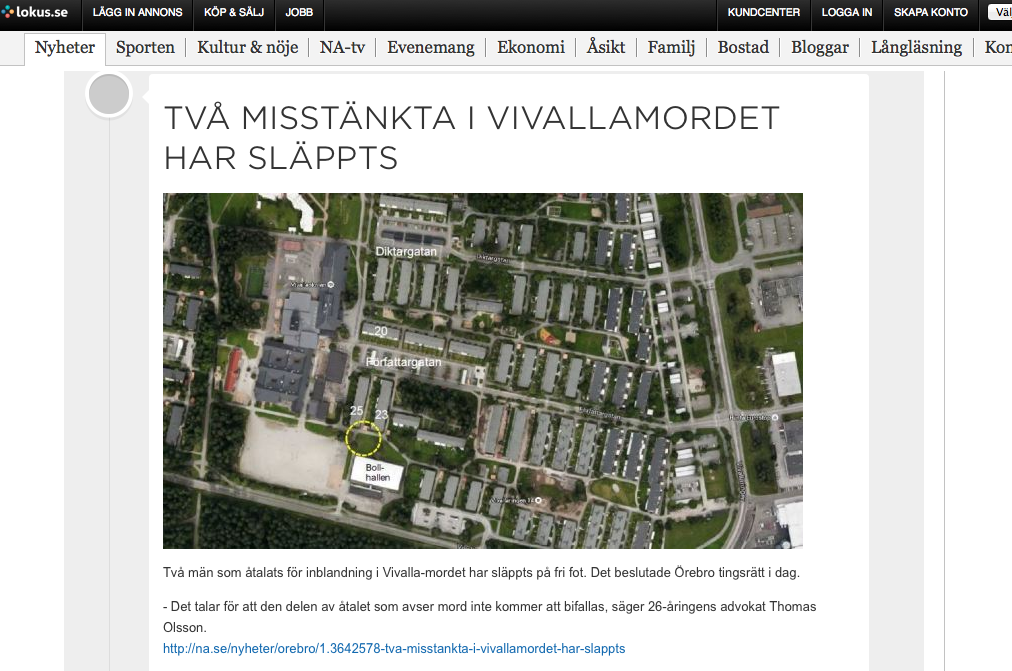Categories
Archives
 At our three-day summer meeting in Stockholm, 13-15 June 2016, about 30 IPTC member delegates and 10 invited experts networked and discussed emerging issues and challenges affecting technology and the news industry.
At our three-day summer meeting in Stockholm, 13-15 June 2016, about 30 IPTC member delegates and 10 invited experts networked and discussed emerging issues and challenges affecting technology and the news industry.
Thanks to the several news agencies and vendors who gave examples of IPTC standards as the backbone of their news exchange systems and products:
Mittmedia about its use of APIs, automated creation of text news by text robots, and data-driven journalism; Profium on the use of multicast; VG on integrating newsrooms with product and technology; Infomaker on its Newspilot publishing platform; Swedish news agency TT on their Toolbox and development of digital content, strategies, and new business; Sourcefabric on its Superdesk publishing platform; Journalism++ on robots – when, where why to start; Fotoware on its digital asset management software FotoWeb. Special thanks to Johan Lindgren and TT for helping us navigate Stockholm, as well as coordinate these presentations.
We approved SportsML 3.0, a major upgrade of the premier open standard for sports data, and NewsML-G2 version 2.23 to further refine the most widely-used standard for representing news and events across all media types.
We also talked about ideas for marketing the IPTC and ways to grow our membership. We will increase our discussion of relevant news and events, as well as information about how the IPTC’s work is applied by news companies every day. We plan to produce more hands-on information about photo metadata as, judging from the traffic to our website, that’s something a lot of people are looking for.
A new and exciting way to get involved with the IPTC is EXTRA: The EXTraction Rules Apparatus. We received a grant from Google’s Digital News Initiative to build and freely distribute a multilingual open-source platform for rules-based classification of news content. If that sounds interesting, then get in touch to learn more.
Please consider joining us for our Autumn Meeting in Berlin (24 – 26 October 2016), which will feature a video workshop day, on 25 October. We plan to launch the Video Metadata Hub recommendation, a single set of video metadata properties covering the entire video workflow, including mappings and guidelines for many existing video standards.
If you have any questions about the IPTC or our Berlin meeting, please contact me at chair@iptc.org. I will be happy to discuss the benefits of becoming involved in IPTC or attending our meetings.
Regards,
Stuart Myles
Chairman, IPTC / Director of Information Management, Associated Press
Stockholm photo: Jill Laurinaitis
IPTC’s Summer Meeting takes place 13 June to 15 June in Stockholm. IPTC members, working groups and parties gather three times a year to discuss emerging industry topics, updates to standards and other IPTC projects.
The Summer Meeting will focus on a new major version the standard SportsML 3.0, a final draft of the Video Metadata Hub recommendation and the EXTRA project, funded by a Google DNI grant.
Presentations in Stockholm will be given by IPTC members and invited guests.
The full list of topics and presenters can be found at: https://iptc.org/events/summer-meeting-2016/
 The International Press Telecommunications Council’s (IPTC) Photo Metadata Conference 2016, on May 26 in Zagreb (Croatia), will focus on how to “Keep Metadata Alive and Intact” throughout the life cycle of images.
The International Press Telecommunications Council’s (IPTC) Photo Metadata Conference 2016, on May 26 in Zagreb (Croatia), will focus on how to “Keep Metadata Alive and Intact” throughout the life cycle of images.
Held annually since 2007, this day-long annual event will address how information can be properly retained when images are moved from one person or system to the next, or through archiving processes. Speakers administrating the sessions – among the industry’s most respected experts in image and data management, digital preservation, information architecture, and photography – will show how metadata is produced, used and preserved in new and innovative ways.
The morning session will cover two topics with multiple presentations: “Protecting Metadata While Using Social Media,” which will discuss results of the IPTC Social Media Photo Metadata Test 2016, including the finding that most photo metadata is removed when uploading or downloading images to many popular social media platforms. Some major media companies will discuss how they protect their metadata through this process. “Strongly Attached Metadata: What You Need to Know,” featuring system vendors and speakers from photo businesses as well as a university, will cover how to apply and organize metadata in an efficient way, to keep it alive in distribution chains.
“Much time and money is spent to protect metadata in in-house systems,” said Michael Steidl, managing director of IPTC and lead of its photo metadata workstream. “Therefore it is a business requirement to protect the descriptive data and rights information from getting lost. This conference will raise awareness and share knowledge about how to keep metadata alive.”
During the afternoon sessions, Steidl will present a close to final draft of the much anticipated “IPTC Video Metadata Hub,” a new technical recommendation which has been in development by IPTC since 2014 and is usable across many existing video standards. Sarah Saunders, expert in procurement and implementation of digital asset management systems, will also present the “Cultural Heritage Photo Metadata Panel” for Adobe software, which supports a rich set of metadata for cultural heritage objects shown in images. The panel can be downloaded for free and installed on a computer.
The Photo Metadata Conference 2016 will be held again in conjunction with the annual CEPIC Congress, in Zagreb (Croatia). Photographers, small and large photo agencies and libraries, and trade associations from the photo business are all encouraged to attend. Registration is required, either as participant of the CEPIC Congress, or through the Conference’s registration form.
See detailed agenda and speakers.

The International Press Telecommunications Council (IPTC) will use a grant from the first round of Google’s Digital News Initiative Innovation Fund to build and freely distribute an initial version of EXTRA: The EXTraction Rules Apparatus, a multilingual open-source platform for rules-based classification of news content.
EXTRA will be a classification system for annotating news documents with high-quality subject tags. Such tags will allow publishers to deliver a variety of valuable services including content recommendations, improved advertising targeting and subject-specific content streams, such as alerts and topic pages.
“By creating a freely available rules-based classification engine, IPTC will help publishers to enhance their content with all sorts of metadata services, including enriched search, intelligent recommendations and precise analytics,” said Stuart Myles, chairman of IPTC.
EXTRA will provide news publishers with several key capabilities: the ability to automatically categorize documents by subject (for example, terrorism, sports, names of celebrities); the ability to author classification rule sets tailored to existing taxonomies; and the ability to classify documents using the industry standard IPTC Media Topics taxonomy. Taxonomies are used by many news organizations to classify their content. Classification is used in various ways, including improved online news navigation by grouping and linking, to organize editorial workflows and to enrich search.
So that EXTRA is immediately useful to the news publishing community, IPTC will create different suites of rules in two languages for classifying news documents into the IPTC Media Topics taxonomy, an industry-standard taxonomy used by several leading news providers.
“We hope that the EXTRA project will support a migration in the news publishing community towards a common industry-wide open source platform,” said Michael Steidl, managing director of IPTC. “We believe that a freely available document classification platform will provide great benefit to small-to-medium sized publishers.”
IPTC invites other parties to join the development of EXTRA.
Contact office@iptc.org to learn more, including how you can get involved.
Over €27m has been offered by Google to 128 projects, large and small, from 23 countries across Europe – each designed to advance innovation in the news industry. DNI is a collaboration between Google and news publishers in Europe to support high quality journalism and encourage a more sustainable news ecosystem through technology.
About IPTC: The IPTC, based in London, brings together the world’s leading news agencies, publishers and industry vendors. It develops and promotes efficient technical standards to improve the management and exchange of information between content providers, intermediaries and consumers. The standards enable easy, cost-effective and rapid innovation. Visit www.iptc.org and follow on Twitter: @IPTC
Metadata is of high value for many parties in the photo business: photographers, libraries, agencies, archives. But many consider this only in a very limited context, not across many transitions in a supply chain or for a longer period.
The IPTC Photo Metadata Conference on 26 May 2016 in Zagreb (Croatia, Europe) will address how to avoid losing information when images are moved from one person or system to the next one or if they are kept in an archive for a long term.
All interested parties are welcome to participate: free-lance photographers, small and large picture agencies and libraries, and trade associations from the photo business.
IPTC Releases Results of 2016 Social Media Sites Photo Metadata Test
Important image metadata is not retained in images after upload to some of the most popular social media sites, according to a study by the International Press Telecommunications Council (IPTC). The missing data includes key copyright and identification information as well as descriptive data about the image.
The IPTC, a consortium of over 50 news agencies and media companies, sets international technical standards for news exchange, including metadata embedded in image files. The recent Social Media Sites Photo Metadata Test repeats a survey in 2013; while improvements are noted, some sites scored lower this time around.
The Social Media Sites Photo Metadata Test evaluated 15 top social media sites, and checked if embedded metadata was retained and displayed on upload to the sites or downloads of various version of the image. The results are displayed at www.embeddedmetadata.org/testresults.
Only one social media site, Behance, received favorable results for retaining and displaying embedded data. A few systems retained embedded metadata but failed to use it when displaying metadata on the web site. Ten sites removed at least some metadata when images were downloaded to a desktop environment.
“There are many important reasons to embed and preserve metadata – to protect copyrights, ensure proper licensing, track image use, smooth workflow, and make them searchable on- or offline,” said Michael Steidl, Managing Director of IPTC. “If users provide captions, dates, a copyright notice and the creator within their images, that data shouldn’t be removed when sharing them on social media websites without their knowledge.”
There may be several reasons social media services remove metadata – and some may not be intentional. Test results showed that in some cases, when images were downloaded to a desktop environment, the metadata was preserved if the size of the image remained unchanged. But if the image was rescaled, the metadata was stripped. “The quality assurance of these sites might not be aware that their software strips metadata inadvertently,” said Steidl.
“Because many of the social media sites are essentially free, users become the product, and not necessarily the customers,” said David Riecks, a photographer and metadata consultant who owns ControlledVocabulary.com and worked on the test. “Users are often not aware of these practices. There should be a sweet spot between these social sites preserving all metadata and removing it all. I’d like to see more engineers working together to find solutions.”
The Embedded Metadata Manifesto was launched by IPTC in 2011 to draw attention to the importance of retaining important data embedded in image files. The website, www.embeddedmetadata.org also includes Embedded Metadata Manifesto’s five guidelines for how metadata should be handled and preserved in digital media.
About IPTC: The IPTC, based in London, brings together the world’s leading news agencies, publishers and industry vendors. It develops and promotes efficient technical standards to improve the management and exchange of information between content providers, intermediaries and consumers. The standards enable easy, cost-effective and rapid innovation and include the Photo Metadata standard, the news exchange formats NewsML-G2, SportsML-G2 and NITF, rNews for marking up online news, the rights expression language RightsML, and NewsCodes taxonomies for categorizing news. Visit www.iptc.org and follow on Twitter: @IPTC
Contact: Michael Steidl, Managing Director, mdirector@iptc.org, +44 (20) 3178 4922
David Riecks, photographer and metadata consultant, david@riecks.com, +1 (217) 689-1376
A new version 2.22 of NewsML-G2 is now available as a Developer Release, and can be download from the Release Section of the IPTC Developer Site. This version enhances the existing global standard for multimedia news and events exchange by adding time delimiters for the planning of news coverage and clarifying the rating of news.
Please visit the IPTC Standards Page for a full list of the available IPTC standards.
The latest version of NewsML-G2 is now available as comprehensive Annual Release, and can be download from the Release Section of the IPTC Developer Site. This version enhances the existing global standard for multimedia news and events exchange by adding metadata properties for a part of the content.
The Annual Release of NewsML-G2 includes updates of the XML Schemas, the Specification document and of a set of implementation guidelines documents.
Please visit the IPTC Standards Page for a full list of the available IPTC standards.
IPTC invited experts to the News at a Crossroads symposium on 28 October 2015 to share predictions and outlooks about the most influential factors on the gathering, delivery and marketing of news today today and it brought together about 100 of leaders in the news industry.
Now a full documentation, including video, of this great event is available – come and see.
